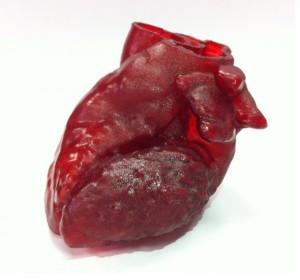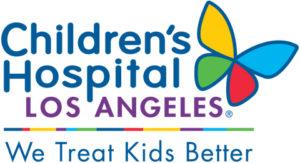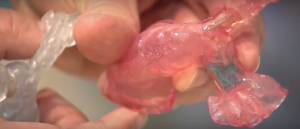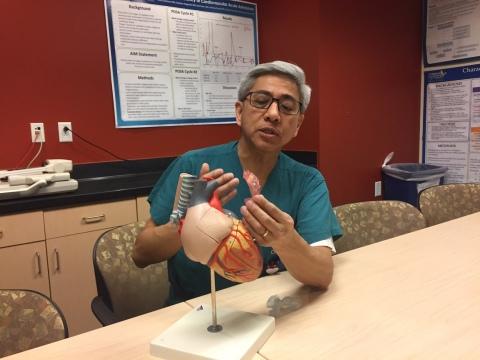3D Printed Heart Model Helps Cardiologist at the Heart Institute at CHLA to Create Special Stent for a Toddler
 It’s almost time for Valentine’s Day, that holiday of endless hearts and flowers and even some 3D printable gifts. But February 14th is not just Valentine’s Day: it’s also the last day of National Congenital Heart Defects Awareness Week. According to the American Heart Association, out of every thousand births, at least eight babies will be born with a type of congenital heart defect; luckily, most of these are considered mild. A congenital heart defect simply means that the condition is present at birth, and is a defect or abnormality, not a disease. These defects occur when the heart, or blood vessels near the heart, do not develop normally before birth. Defects range in severity, starting with more simple problems to fix, like “holes” between the chambers of the heart, to more severe and possibly life-threatening malformations.
It’s almost time for Valentine’s Day, that holiday of endless hearts and flowers and even some 3D printable gifts. But February 14th is not just Valentine’s Day: it’s also the last day of National Congenital Heart Defects Awareness Week. According to the American Heart Association, out of every thousand births, at least eight babies will be born with a type of congenital heart defect; luckily, most of these are considered mild. A congenital heart defect simply means that the condition is present at birth, and is a defect or abnormality, not a disease. These defects occur when the heart, or blood vessels near the heart, do not develop normally before birth. Defects range in severity, starting with more simple problems to fix, like “holes” between the chambers of the heart, to more severe and possibly life-threatening malformations.
 At the Heart Institute at Children’s Hospital Los Angeles (CHLA), the doctors deal with all levels of congenital heart defects. The Institute has a “history of treating small hearts with big problems” and completed the first pediatric heart surgery on the West Coast back in the 1930s. To this day, the Institute is known for taking on complex cases and getting “impressive health outcomes,” and will sometimes even turn to 3D printed models to help get the job done.
At the Heart Institute at Children’s Hospital Los Angeles (CHLA), the doctors deal with all levels of congenital heart defects. The Institute has a “history of treating small hearts with big problems” and completed the first pediatric heart surgery on the West Coast back in the 1930s. To this day, the Institute is known for taking on complex cases and getting “impressive health outcomes,” and will sometimes even turn to 3D printed models to help get the job done.
Nate Yamane was born in June 2015 and had trouble breathing shortly after birth. It turned out that Nate had tetralogy of Fallot (TOF) with pulmonary atresia – the genetic abnormality caused an obstruction to his pulmonary artery, so blood pumped by the heart was prevented from flowing into his lungs. He was taken to CHLA in critical condition. Pulmonary atresia is a more severe form of TOF, and about one in 10,000 children are born this this defect. It occurs when the pulmonary artery does not form properly in utero. To combat this, the body grows “collateral arteries” that will redirect blood flow to the lungs and bypass the obstruction.
“Imagine blood flowing in the artery like cars on the freeway, and it’s blocked,” explained Pediatric Interventional Cardiologist Dr. Frank Ing, Chief of the Division of Cardiology and Co-Director of the Heart Institute at CHLA. “Cars exit and find an alternate route to its destination; blood does the same, and in this case finds its way through collateral vessels to the lungs.”
 To keep the heart from failing, these vessels need to be rebuilt quickly after birth. Surgeons are able to repair them by sewing them together, in a surgical technique called unifocalization. Dr. Ing, also a professor of Clinical Pediatrics and Medicine at the Keck School of Medicine of the University of Southern California, said that doctors will use “whatever the body gives us” in order to fix these kinds of issues.
To keep the heart from failing, these vessels need to be rebuilt quickly after birth. Surgeons are able to repair them by sewing them together, in a surgical technique called unifocalization. Dr. Ing, also a professor of Clinical Pediatrics and Medicine at the Keck School of Medicine of the University of Southern California, said that doctors will use “whatever the body gives us” in order to fix these kinds of issues.
Nate had a catheterization procedure and two open heart surgeries by the time he was a month old, and that wasn’t even the end of it. Six months into his young life, doctors discovered that Nate’s pulmonary arteries, in the left and right branches, were narrowed. Dr. Ing led a team that was able to open up the right branch using a balloon, but it wasn’t that easy to open up the left. Doctors had to insert a special stent into the narrowed section of Nate’s left pulmonary artery, which at the time was about 15 mm. Stents normally don’t come that small, but Dr. Ing was able to develop a technique to modify it to fit Nate.
In order to get the measurements exactly right before the procedure, doctors created a 3D printed model of the obstructed region of Nate’s pulmonary artery, using CT scans of his heart, to use as a guide. Dr. Ing was then able to make a custom, fully functional stent by cutting the smallest stent they had and folding it back on itself.

Dr. Frank Ing, Chief of the Division of Cardiology and Co-Director of the Heart Institute at Children’s Hospital Los Angeles [Photo: Children’s Hospital Los Angeles]
Dr. Ing said, “I have to say, the 3-D model was very helpful because it gave me confidence that [the size of the stent] was going to work.”
His fix worked: the stent fit exactly into the narrowed artery in the model, and when they inserted it into Nate’s actual artery, it was perfect, and didn’t jut out into other areas. Dr. Ing saw almost immediate improvement in Nate’s blood flow and a healthy drop in his blood pressure. But later, CHLA cardiologists discovered that a portion of Nate’s right artery was narrowing again, and it was determined that a stent would also be needed to keep that artery open. They ran into the same issue as before: due to the narrowed size (about 9 mm), they needed to create another custom stent to fit into the small opening. But Nate needed to grow a little bigger and stronger first, before the doctors would attempt a second procedure; his mother, Courtney, said they did some “physical therapy and tried to fatten him up” first.
Last month, in front of an international audience of cardiologists who were tuned in to a live video feed at Miami’s Pediatric and Adult Interventional Cardiac Symposium in Miami, Dr. Ing entered CHLA’s catheterization lab and inserted the second, smaller stent into now 19-month-old Nate’s right pulmonary artery. Just like the last time, the stent had been modified ahead of time to the exact specification of the 3D printed model. Dr. Ing and his team were able to successfully open up Nate’s narrowed right pulmonary artery, and Nate’s oxygen levels got better overnight. Unfortunately, this will not be Nate’s last procedure: he will more surgeries in the coming months and years, but he’s already doing better. His mother says he’s eating better, and getting stronger.“He’s rolling around with energy and even took his first baby steps. There’s a big difference and a lot of improvement. We’re going in the right direction,” said Courtney.
Take a look at the video of the live feed from Nate’s second stent surgery last month:
Discuss in the 3D Printed Heart Model forum at 3DPB.com.
[Source/Images: Heart Institute at CHLA]
Subscribe to Our Email Newsletter
Stay up-to-date on all the latest news from the 3D printing industry and receive information and offers from third party vendors.
Print Services
You May Also Like
New Business: Temporary, Migratory, & Modular 3D Printed Architecture
If we look at potentially emerging 3D printing businesses, then architecture has not been fully explored. Yes, there is a lot of house 3D printing going on worldwide. From deployable...
3D Printing News Briefs, April 19, 2025: Material Extrusion Standard, Metal Powder, & More
In today’s 3D Printing News Briefs, we’re covering a proposed standard for material extrusion, before moving on to business and metal powder. We’ll end with a commercial store’s robotic 3D...
Japan Unveils World’s First 3D Printed Train Station
Japan is now home to what we believe is the world’s first train station built with 3D printing technology. Located in Arida City, just south of Osaka, the new Hatsushima...
restor3d Raises $38M to Expand 3D Printed Orthopedic Implants
Backed by $38 million in new funding, restor3d is pushing ahead with the launch of four personalized implant lines, set to roll out in 2025 and 2026. This latest venture...


























